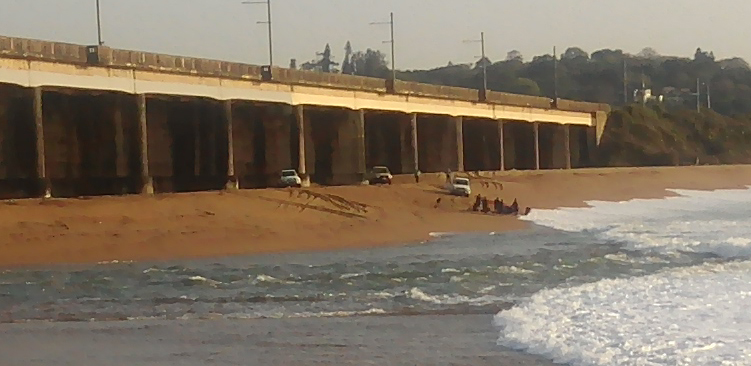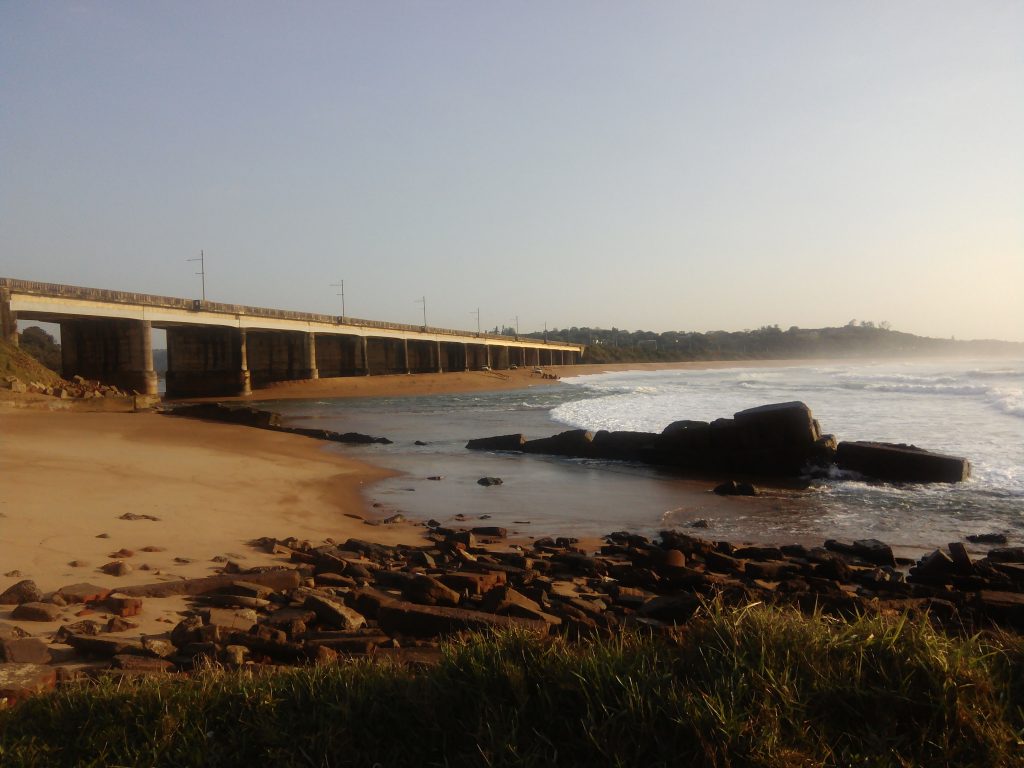
And the Umzimkulu mouth claims another victim
The team were quick and slick. When we got down to the mouth at The Block, the boat was half way up the beach. The tide must have been really high when they went over. The motors were buried in the sand upside down. Anchoring the boat where it was. The guilty looking sandbank was exposed now. But the team were quick into salvage mode and dug a little ditch all the way under the gunwhale facing us. They got into the ditch and in a massive effort, lifted that heavy duty old style mono hull onto it’s far gunwhale. Teetering for a few seconds, she gracefully rolled over right way up. The three land cruisers present fired up and in no time flat, the boat was right on top of the Sandspit. The beach was cleared, and they were gone.

It was the Kwazulu Natal Sharks Board. On a Monday morning. Troops following orders. Perfectly.
But it’s these orders I have a problem with. Launch a boat of souls, out through dangerous surf conditions, every few days. With very expensive equipment. Drop 100 metre long gill nets at our favourite beaches, that get smack bang in the way of protected marine mammals. And kill sharks and anything else that gets caught in them. Breaking the law!
Who could issue orders like this? Learned people? Scientists? Who gives these orders?
When there are just so many technological options that can be deployed to protect both the environment and the people, these modern days.
Firstly. The incident described above, happened on a Monday morning. The sea was wild. Who are these nets protecting? Maybe 50 surfers and 100 bathers? From Richards Bay to Port Edward? On a good day? 1000 Surfers? 2000 Bathers? In season, ok, far bigger numbers and this is what the nets were deployed for in the first place. After Black December in the 60’s, where a few bathers were chowed (a fraction of the road deaths that same season), the nets went in. The brainchild of who knows. But the concept stuck. Thousands upon thousands of marine animals died. And are still dying. The nets simply reduce the shark population in an area.
Even this week, I received a report of yet another whale stuck in the nets. Another dead whale. This time at Uvongo. Others were at Umhlanga. Richards Bay. Trafalgar. This year alone.
The nets are simply illegal gill nets. They just kill.
Alternatives
Shark Shields
At R100 000 000 plus per year from the government and each guilty municipality, where these killing machines are installed, the KZNSB guys have the very best equipment, resources, and staff. This is big money. Recapitalisation. Rolling stock. Boats. Nets. Petrol.
Lets start with surfers. Lets take a really busy Saturday, out of season. The surf is cooking. Like today!
Back to those numbers: Port Edward has a few locals, and a few more are sprinkled towards Margate. Saints would have 30 guys. Umzumbe too. Then the unnetted secret spots up toward Scotties, may have 20 guys out, Scotties could have 30 too. Greenies and surrounding secrets, perhaps 30 more. Warners and Toti area would be quite busy, say 100. Durban 300? North to Umhlanga, maybe 100 more. North of that, secret spots, up to Richards Bay – perhaps 50. In the water.
About 800 surfers. All invading the home of the shark. On an almost daily basis.
Lets take it to 1000 surfers. Give each one a Shark Shield to use. At R8000 or so. To use when they need them. Comes to a mere R8 000 000. Job done, nets out. The existing personnel would manage the project. The devices would not be rented, but given to the public, to be returned after a swim or a surf or a dive. To protect them. And the marine life. Same time. Controlled by existing infrastructure and resources. KZNSB staff. Imagine the fuel savings by not launching banned two stroke outboard powered boats and a crew to mesh the nets?
Lets do the bathers on this same busy Saturday. Same zone. About the same? Or lets say double…another 2000 people in the water at the same time. R16 000 000. Job done, nets out. Sharks and humans safe. Recapitilisation extended to over a five-year cycle. A massive saving.
Holiday season. Well. Sell Shark Shields to everyone who can afford them. Or subsidise at least. And put the rest in a queue for Sharks Board free issue, whenever they feel like hitting the mid-break. ID card if necessary. Return the device and get your ID back. Work with the lifeguards. Save marine animals and humans. But rather, for when it’s really busy, see the next few options…
The profits that the Ozzies will make from just us, will bring the price down too. How funny that the KZNSB actually had the shark shield technology first? But then lost it to the Ozzies. Sounds like rugby. The Ozzies are flying with this tech. https://sharkshield.com/
Research shows that sharks are cognitive, and that when they have a bad experience somewhere, they like to stay away from that area. This research came from Australia as usual, where sharks caught by a drum line, did not come back to the scene. As much as drum lines are better than nets, new technology leads me to leave this option out. But if sharks start associated certain beaches with getting a bit of an electrical tickle to the nose, they should stay away from those spots.
Tidal Pools
Evironmentalist Kathy Costello down in Port St. Johns is campaigning hard for their tidal pool, at 2nd Beach in Port St. Johns. The most dangerous beach in the world has not only been plagued by shark attacks, but also drownings. A tidal pool solves both these problems. Surfers can take shark shields and surf all those uncrowded spots, shark attack proof.
Durban doesn’t have a tidal pool along it’s strip? It would be a lot easier to manage the crowds if they are all contained in a safe and waist deep tidal pool. A huge one could be built. Water pumped through if necessary. So much safer. Allowing the public at large to use the ocean in such masses on those busy days, always ends in drama.
Exclusion Nets
An extremely successful exclusion net trial at Fish Hoek, in Cape Town, was carried out, a few years back. During which they monitored shark behaviour. White sharks. They didn’t even try to get through the visible barrier. It has smaller holes that catch relatively nothing. And can be removed when there are no takers for a dunk. Exclusion nets could easily be deployed in Durban, on most days. On the bad weather and rough sea days, these nets can stay out of the water. Interfering only when there are bathers. Their soft rubber material make-up poses little threat to any marine animal.
Latest news I could find on the Fish Hoek exclusion net: http://www.capetowngreenmap.co.za/blog/fish-hoek-shark-exclusion-net-deployed.
The highly successful initiative – The Shark Spotters, are doing a great job keeping the sharks at bay. Short video of the first exclusion net trialled at Fish Hoek, back in 2013.
At Umtentweni and a few other beaches, the remains of the very first measures against shark attack can be clearly seen. The pillars that the old tennis net was wired to, stand proud. Exclusion nets. So simple and environmentally sound. And oh so cheap and easy!
Sonar
Well our very same sharks board were offered this technology a decade back, and they shunned it completely. Once again, just as in rugby, the Ozzies ran with it, and have produced amazing technology that can see sharks coming, underwater. The sonar sends it’s signal back to a control point, where alarms can be sounded and other measures temporarily implemented. When the shark moves off, it’s safe again.
http://www.sharkmitigation.com/sonar-clever-buoy.html Tells the whole story, video and all…this tech is being rolled out at Southern California beaches right now.
Last word…
From Wikipedia: Total cost for the Shark netting program in NSW for the 2009/10 year was approximately AUD 1m, which included the cost of the nets, contractors, observers and shark technician, shark meshing equipment (dolphin pingers and whale alarms etc.), and compliance audit activities.[4] For the 51 beaches protected,[4] this represents a financial cost of approximately AUD$20,000 per beach per year.
Our KZNSB only mesh 40 beaches for R100 000 000 and growing. Where can all that money go? The Ozzies do the job at 51 beaches, for R212 000 per beach per year (2010). Our guys are burning R2 000 000 per year PLUS per beach?! It seems that under the guise of the Zuma principled Operation Phakisa, they are allowed to blow our money out like this. Job creation they call it. National Development Plan. Unsustainable as is currently evident by the KZNSB financial status. 80% of the R100 000 000 they spend each year is on salaries. To protect 20 beaches?!
The fact that the existing government is trying to merge the KZNSB (wild life killers) with the Ezimvelo (wild life savers: previously the highly successful Natal Parks Board -an organisation built to save wild life), now also a failing organisation, is an opportunity to get this all right.
How do we get to that table now?
PS Sign the petition at the link below please! It seems there are only 6000 or so of us ocean lovers who are concerned, so far.
https://www.change.org/p/sean-a-lange-kwazulu-natal-shark-net-killing-machines-out
And, just to make sure we are all on the same page…some humour on the topic…
